Exhibition design with installation assistance by Lauren Gideonse
Curator: Mimi Zeiger for the MAK Center for Art & Architecture @ The Schindler House
Graphic design: still room studio
Photography: Taiyo Watanabe
Architects/artists: AGENdA agencia de arquitectura (Medellin, Columbia), Pedro Ignacio Alonso and Hugo Palmarola (Santiago, Chile), Tanya Aguiñiga (Los Angeles), Laurel Consuelo Broughton (Los Angeles), Design, Bitches (Los Angeles,) Sonja Gerdes (Los Angeles and Berlin), Bettina Hubby (Los Angeles), Alice Lang (Los Angeles), Leong Leong (New York), Jorge Otero-Pailos (New York), Anna Puigjaner – MAIO (Barcelona, Spain), and Bryony Roberts (New York)
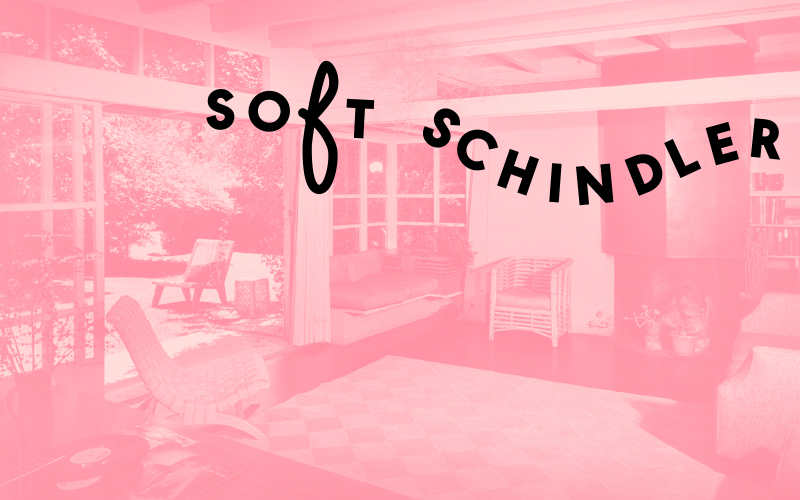
Exhibition catalog
Soft Schindler begins with traces of pink paint on redwood-faint evidence of when in late 1949 Pauline Schindler, estranged from her architect husband but living in half of the house they built together, painted her side of the interior salmon pink. To R.M. Schindler, Pauline’s intolerable act violated a sanctum of modernism and his desire for honest expression of natural materials. This exhibition, however, interprets her act as softening our understanding of house as manifesto-softness as resistance-and yields to plural narratives that lay interpretive ground for contemporary artworks and architectural installations.
The Schindler House has never been a binary. “Both/and” to its core, the house contains nearly a century of fluid, alternating domesticities: dinner parties, political debates, and love affairs. It was the salon of art dealer Galka Scheyer and the stage for clashes with architect Richard Neutra. Archival photographs suggest material legacies in dialogue with Schindler‘s rigorous geometries: tablecloths, pillows, curtains, flower pots-ephemeral elements that like the pink paint were not preserved when the residence was restored in the 1990s in approximation of the original intentions of the architect.
Soft Schindler participants, through their respective practices and presented works, show the incompleteness of binary ideas in architecture, sculpture, and design-femininity vs. masculinity, inside vs. outside, heavy vs. light, rational vs. emotional-framing such notions outmoded. Each of these practitioners makes non-conforming aesthetics and ideologies manifest in space.
Ultimately, Soft Schindler uses the concept of softness to encourage a politics of reevaluation: If this space/sculpture/material isn’t what was first assumed, what other assumptions need challenging?
***
Mimi Zeiger is a Los Angeles-based critic, editor, and curator. Her work is situated at the intersection of architecture and media cultures. She co-curated the US Pavilion at the 2018 Venice Architecture Biennale. She has written for The New York Times, Domus, Architectural Review, Architect, where she is a contributing editor, and is an opinion columnist for Dezeen. Zeiger is the 2015 recipient of the Bradford Williams Medal for excellence in writing about landscape architecture. She has curated, contributed to, and collaborated on projects that have been shown at the Art Institute of Chicago, 2012 Venice Architecture Biennale, New Museum, Storefront for Art and Architecture, and the Architectural Association. She co-curated Now, There: Scenes from the Post-Geographic City, which received the Bronze Dragon at the 2015 Bi-City Biennale of Urbanism\Architecture, Shenzhen. She teaches at SCI-Arc and Art Center.
***
Unique in its role as an historic site and exhibition space, the MAK Center for Art & Architecture develops local and international projects exploring the intersection of contemporary art and architecture. Acting as a public platform for current issues, the Center encourages exploration of practical or theoretical aspects in art and architecture by engaging the MAK Center’s places, spaces, and histories. Established in 1994, the Center is housed in the landmark R. M. Schindler House (1921-22) in West Hollywood. In addition, the Center maintains and occupies two other Schindler-designed buildings, the Mackey Apartments (1939) and the Fitzpatrick-Leland House (1936).
***
ARCHITECTS & ARTISTS
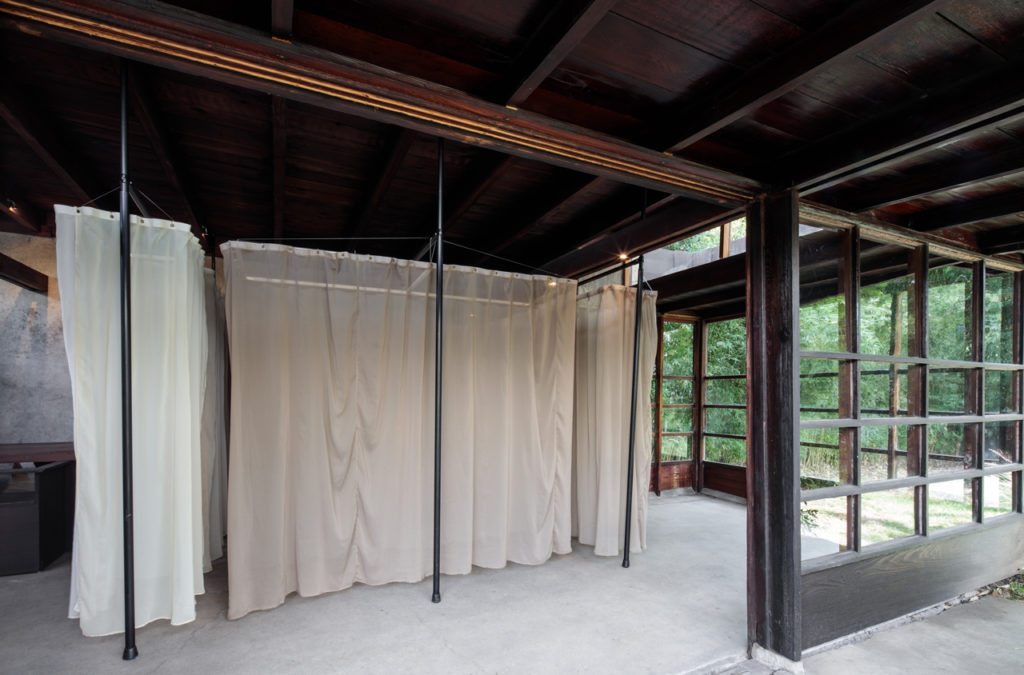
AgendA agencia de arquitectura, “The Garden of Earthly Delights,” 2019. Photo © Taiyo Watanabe. Courtesy of the MAK Center for Art and Architecture.
AGENdA agencia de arquitectura is located in Medellin, Colombia and founded in 2010 by Camilo Restrepo Ochoa and Juliana Gallego Martínez. AGENdA searches for possible architectures no matter the scale or location. AGENdA articulates dialogues, project, and questions regarding architecture’s disciplinary issues and practice from a condition of crossroad between tropical conditions, history, and disciplinary matters with special attention to uncertain conditions as a response to specific realities and context.
a
Architect Camilo Restrepo Ochoa graduated from Universidad Pontificia Bolivariana in Medellin in 1998. He was a guest lecturer at Harvard Graduate School of Design from 2014 to 2017. Camilo was nominated for the MCHAP price in 2014, BSi Prize in 2014, and one of the three finalists of the Rolex Mentor Protege in 2012.

Pedro Alonso and Hugo Palmarola, “Choreographies,” Photo © Taiyo Watanabe. Courtesy of the MAK Center for Art and Architecture.
Pedro Ignacio Alonso is an architect and MSc in architecture, PUCCh, 2000, and Ph.D in Architecture, AA 2008. He is Associate Professor at the Universidad Católica de Chile, Visiting Professor at the Architectural Association, and Princeton-Mellon Fellow 2015-2016 at Princeton University. Together with Hugo Palmarola he was awarded a Silver Lion as curator of the Chile Pavilion, Monolith Controversies, at the 14th Venice Architecture Biennale (2014). His publications include Panel (London: AA, 2014), Monolith Controversies (Hatje Cantz, 2014), and Space Race Archaeologies (Berlin: DOM, 2016).
a
Hugo Palmarola is a designer at The Catholic University of Chile (2004), MA in Theory and History of Design at The National Autonomous University of Mexico (2010). Together with Pedro Alonso he was awarded a Silver Lion as curator of the Chile Pavilion, Monolith Controversies, at the 14th Venice Architecture Biennale (2014). His publications include Panel (London: AA, 2014) and Monolith Controversies (Hatje Cantz, 2014) which was awarded a DAM Architectural Book Award from the Deutsches Architekturmuseum (2014). Palmarola won the Student Essay Prize awarded by the Design History Society (2018). He is Assistant Professor at the Pontificia Universidad Católica de Chile.

Soft Schindler, with works by (L-R) Alice Lang, Laurel Consuelo Broughton—WELCOME PROJECTS, Tanya Aguiñiga, and Bryony Roberts Studio. Photo © Taiyo Watanabe. Courtesy of the MAK Center for Art and Architecture.
Tanya Aguiñiga, born in 1978, is a Los Angeles based artist/designer/craftsperson who was raised in Tijuana, Mexico. She holds an MFA in furniture design from Rhode Island School of Design and a BA from San Diego State University. Her work uses craft as a performative medium to generate dialogues about identity, culture, and gender while creating community. Aguiñiga is the founder and director of AMBOS (Art Made Between Opposite Sides), an ongoing series addressing bi-national transition and identity in US/Mexico border regions.
a
Recent solo exhibitions include Disrupting Craft: Renwick Invitational 2018 at the Smithsonian American Art Museum, Washington D.C. and Craft and Care at the Museum of Arts and Design, New York. Aguiñiga is the inaugural fellow for Americans for the Arts Johnson Fellowship for Artists Transforming Communities, a United States Artists Target Fellow, and a NALAC and Creative Capital Grant Awardee. She was featured in American Craft magazine and PBS’s Craft in America series.
a
Laurel Consuelo Broughton is a designer, artist and educator. She works in Los Angeles with her studio WELCOMEPROJECTS at many scales.
a
Alice Lang is an Australian artist currently based in Los Angeles. Her cross-disciplinary art practice utilizes a variety of media such as ceramics and painting to examine how existing power structures disseminate and manifest within individual bodies and mass culture. Her work examines the way in which culture and context influence the meaning and value of text, objects and images and how this shifting relationship can be used to subvert dominant paradigms and reclaim space for female voices.
a
Lang graduated from the MFA program at CalArts in 2015 and has completed residencies in Canada, New York and Los Angeles. She has been the recipient of awards such as the Queensland Art Gallery Melville Haysom Scholarship (2009), Australia Council New Work Grant (2012), Lord Mayors Emerging Artist Fellowship (2012) and the Freedman Foundation Traveling Scholarship for Emerging Artists (2013). She is also a founding member of the feminist art collective LEVEL which is based in Brisbane, Australia.
a
Bryony Roberts is an architectural designer and scholar. Her practice, Bryony Roberts Studio, integrates strategies from architecture, art, and preservation to respond to complex cultural sites. Her practice has been supported by the National Endowment for the Arts, the Graham Foundation, the MacDowell Colony, and the American Academy in Rome, where she received the Rome Prize for 2015-2016. She has published her research in the Harvard Design Magazine, Log, Future Anterior, and Architectural Record, co-edited the volume Log 31: New Ancients, and recently edited a book titled Tabula Plena: Forms of Urban Preservation published by Lars Müller Publishers. Roberts teaches architecture and preservation at the Columbia University Graduate School of Architecture, Planning and Preservation in New York.

Design, Bitches, “Drawing Rooms,” 2019. Photo © Taiyo Watanabe. Courtesy of the MAK Center for Art and Architecture.
Catherine Johnson, AIA and Rebecca Rudolph, AIA founded Design, Bitches with a bold and irreverent vision to make architecture significant in daily life. Their multidisciplinary firm draws inspiration from the duos’ eclectic expertise in the areas of design, art, and pop culture. Each design transforms a collage of influences into architecture that is beautiful and layered with meaning, but also welcoming-spaces and landscapes where people want to hang out.
a
Design, Bitches work has been recognized with multiple awards from the AIA/LA, Surface, Architect’s Newspaper, shortlisted for the Moira Gemmill Prize for Emerging Architecture, and selected as the 2017 recipient of AIA/LA’s Emerging Practice Award. Catherine and Rebecca co-taught at the University of Oregon in 2018 and lectured at Columbia University, Yale University, CalArts, SCI-Arc and George Washington University.
a
Catherine & Rebecca are native Californians. Catherine received her MARCH from SCI-Arc and her BIARC from the University of Oregon; Rebecca received her MARCH from SCI-Arc and a Master of Philosophy from the University of Paris VIII.

Sonja Gerdes, “Pie of Trouble. Stays Trouble. Belly on Belly. Let’s Hang. Breathe you infinite. Animal Creature Plant Breath Soul. The Energy Plan. Amorphous Hypersensibility. Do Spiders Breathe? Mothersmilk. The Multiple Amorphous Us. Air For Free.,” 2019. Photo © Taiyo Watanabe. Courtesy of the MAK Center for Art and Architecture.
Sonja Gerdes was born in Germany. She studied at the University of the Arts in Berlin, and from 2007-2013, co-ran the Berlin-based artist run space, Infernoesque. She lives and works in Los Angeles and Berlin. Her practice is defined by the relationship and interactions between the body, energy, and air and what it means to be human. She’s recently exhibited at Gas Gallery, Los Angeles; Cloaca Projects, San Francisco; Cirrus Gallery, Los Angeles; The Pit, Los Angeles, CA; Kavi Gupta Gallery, Berlin; Sabine Knust Gallery, Munich.
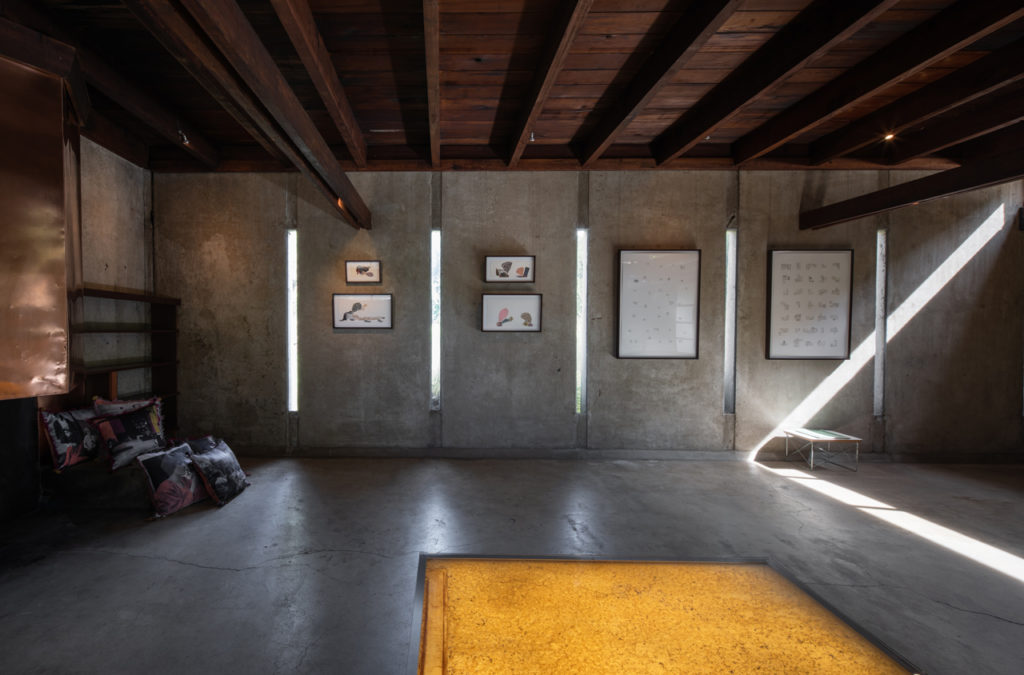
Soft Schindler, with works by (L-R) Bettina Hubby, Anna Puigjaner—MAIO, and Jorge Otero-Pailos. Photo © Taiyo Watanabe. Courtesy of the MAK Center for Art and Architecture.
Bettina Hubby‘s practice is wide-ranging, encompassing curatorial and project-based work as well as collage, drawing, printmaking, sculpture, video and photography. Hubby’s projects engage diverse communities and often exist in settings that challenge the conventions of exhibition spaces, celebrating collaboration and resisting easy categorization. For the last few years her work has dealt with advice, clichés, and anti-subliminal and anti-subtle art. Humor is her mainstay medium.
a
Anna Puigjaner is an Associate Professor of Professional Practice at Columbia GSAPP. She unites theory and practice by combining academic, research, and editorial work with the professional activity of MAIO, an architectural office co-founded in Barcelona in 2012. She received Harvard GSD’s Wheelwright Prize in 2016 and was nominated as a finalist in the Rolex Mentor and Protégé Initiative. As an editor, she has run the magazine Quaderns d’Arquitectura i Urbanisme for the past six years. Her ongoing research and writing on the “Kitchenless City” has been published in different forms, including in The Quantified Home (Lars Müller Publishers, 2014) and Together! The New Architecture of the Collective (Ruby Press, 2017).
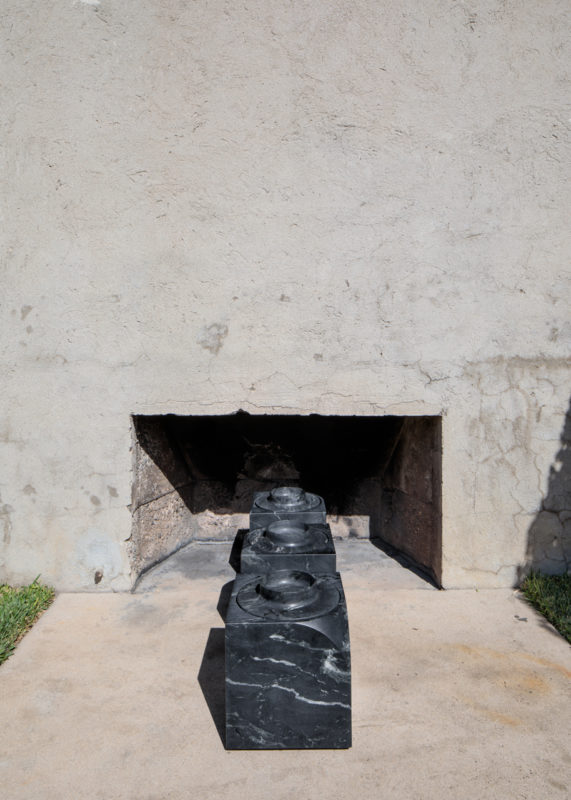
Leong Leong, “Fermentation 01,” 2019. With fermentations by Jessica Wang and Ai Fujimoto. Photo © Taiyo Watanabe. Courtesy of the MAK Center for Art and Architecture.
Leong Leong, founded in 2009 in New York, by Chris and Dominic Leong, Leong Leong works globally and at many scales including buildings, interiors, exhibitions, and furniture. The studio has been the recipient of the Architectural League of New York’s Emerging Voices Award, the AIA New York New Practices Award, and has been recognized as a Design Vanguard by Architectural Record. In 2014, Leong Leong designed the U.S. Pavilion for the 14th Venice Architecture Biennale and has been exhibited in The Guggenheim Museum Bilbao and MoMA.
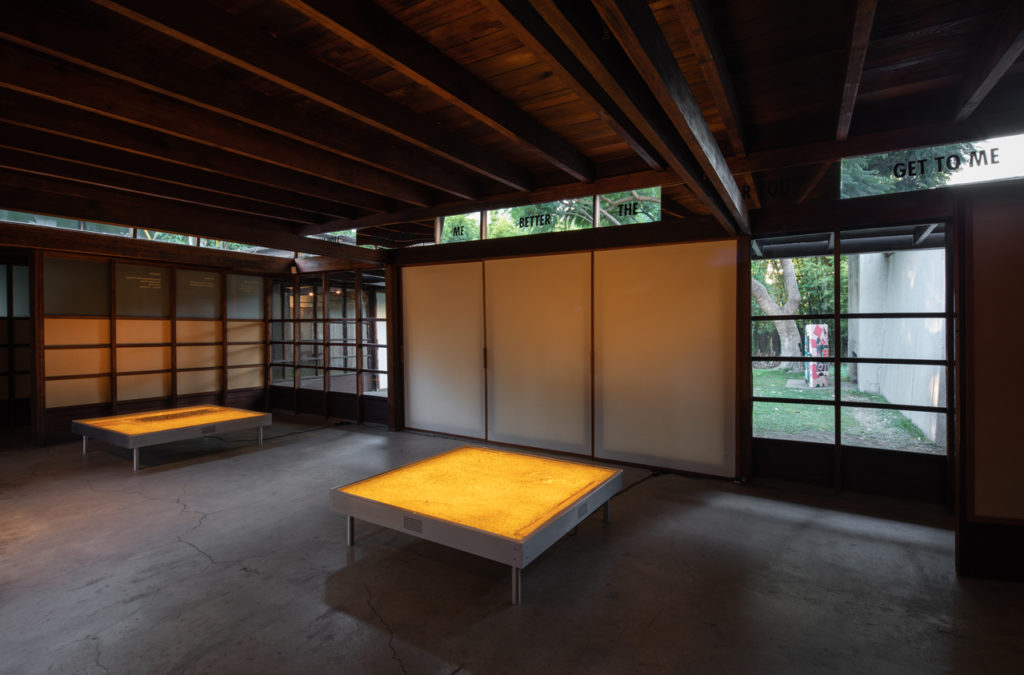
Jorge Otero-Pailos, “Répétiteur 3,” 2018; “Répétiteur 4,” 2018. Clerestory windows: Design, Bitches, “Don’t! I will.,” 2019. Photo © Taiyo Watanabe. Courtesy of the MAK Center for Art and Architecture.
Jorge Otero-Pailos is a Spanish born, New York-based artist and preservationist best known for making monumental artworks out of historically charged buildings. Drawing from his formal training in architecture and preservation, Otero-Pailos’ art practice deals with memory, culture, and transitions, and invites the viewer to consider buildings and functional objects as powerful agents of change. His work received critical acclaim from the Guardian and the New York Times and is in the collections of SFMoMA, The British Museum, and Thyssen-Bornemisza Art Contemporary. He participated in the 53rd Venice Art Biennale (2009) and the Chicago Architecture Biennial (2017). He is Director and Professor of Historic Preservation at the Columbia University Graduate School of Architecture, Planning and Preservation. He studied architecture at Cornell University and earned a doctorate in architecture at M.I.T.
a
***
a
Support provided by:
Graham Foundation for Advanced Studies in the Fine Arts
Pasadena Arts Council
Columbia University Graduate School of Architecture, Planning and Preservation
Southern California Institute of Architecture
a
***
a









